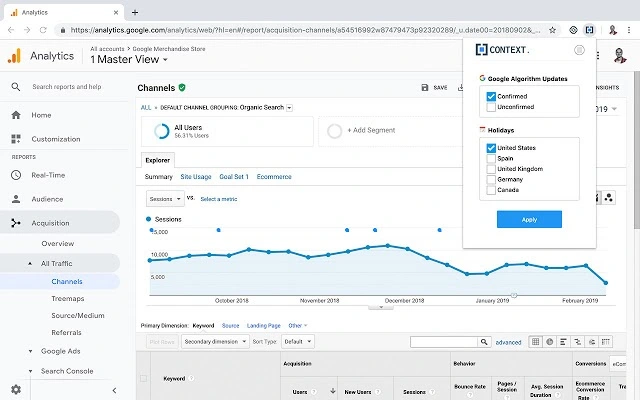eCommerce analytics sounds unfamiliar, yet important. The internet promoting space is in consistent moves as new advances, administrations, and advertising strategies acquire ubiquity and become the new norm. Online storekeepers are one of the various portions influenced by these consistent developments. All together for these entrepreneurs to endure and flourish, they should have the option to settle on better choices quicker.
In eCommerce, your clients have all the force. They are furnished with dependable item surveys from their companions, the capacity to rapidly analyze costs between online stores, and the chance to cast a ballot with their wallets.
Their assumptions are high and to give them the motivation to purchase from you, you need to offer them the most ideal web-based shopping experience. Regardless of your point of view, there is just something single that will assist you with doing it right: data.
This is the reason for the existence of eCommerce Analytics. But what is eCommerce analytics?
Table of Contents
Definition of eCommerce analytics
eCommerce Analytics is a term used to describe business activities and techniques to systematically analyze data to improve the business results of companies selling online. This broad definition includes activities such as collecting business requirements, executing analytical programs and projects, distributing and socializing business analytics, and managing the continuity of supply and demand for analytics.
A wide range of individuals and organizations that have close ties to the business with demand for services in eCommerce companies will come from senior leaders, CxO to the leaders of sales, purchasing, planning, marketing, finance, user experience, design, customer service, inventory, storage, implementation, etc.
eCommerce Analysis also involves working with engineering and information technology groups in developing appropriate software and Internet networks. It requires the analytics team to participate and can lead the technical activities necessary to perform or assist the analysis, such as data acquisition, extraction, loading, transformation, administration, and security and privacy protection.

eCommerce Analytics can include understanding and implementing dimension data models, working with databases, processing data, creating and executing queries, defining data flows, joining join data management, acting as a data manager, working with and identifying metadata, and using tools to analyze data, visualize data, and do data science and advanced analysis.
All of these tasks happen in an enterprise organization with its own culture and way of working, in which the analyst team must integrate and learn to support and guide to drive business data information results. Successful analysis often requires reviewing and reorganizing a company structure, including new roles in top management, such as chief analytics, data manager, and research director data rescue.
The importance of eCommerce analytics
Now that you know what is eCommerce analytics, so why this is an important tool for your online businesses?
People experience eCommerce with certain goals: to learn more about products by reading product information and reviews, to compare prices and promotions, and to buy products. eCommerce sites that win this zero-sum game are companies that can tie the aforementioned intentions to a product and generate sales.
The top eCommerce companies use data and analytics to compete with each other, and they use a lot of different data to do it. Data is collected and analyzed about who visits an eCommerce website, when they visit, which site they see, and which website or source (from which referral or marketing channel).
Other information about user behavior is also collected, such as user interactions and activity on the page, data related to products viewed, advertisements used, pages visited, view time, page paths and clicks, queries entered in a search, and more, such as order value, product prices, shipping methods used, and more payment messages.
Customer data can be collected or inferred, such as who customers are or where they might be, where they live, what they like, their interests or trends, what they have purchased, other information on demographics and psychology, etc.
All of this data, the people, the workgroups, and the data analysis, as well as the performance assistants, are powerful resources for eCommerce companies to run their businesses. But data must be collected and analyzed efficiently and accurately so that companies using it can create better experiences, make better decisions, drive customer conversion, satisfaction, and keep. customer base, and thereby increase sales, growth, profitability, and business value.

The efficient use of eCommerce and related data requires investment in an analytical value chain, from technology to people, processes, governance, and the necessary changes related to management. That way, it can bring material benefits by investing in analytics and converting more users into customers, providing insights into customer behaviors and trends (insight) to improve their experience.
Profits from investing in eCommerce Analytics can also be received from improving marketing, tracking marketing and advertising costs, and profits. The impact of sales programs can be seen as a result of sales and other financial metrics. Transaction details, product-related metrics, and key performance metrics related to a shopping cart can be understood, evaluated, and targeted. Methods to increase competition with this eCommerce data are perfectly viable if you know how to analyze eCommerce.
Metrics to analyze eCommerce data
To make things basic and understood, we’ll separate the most significant web-based business measurements into 5 areas that cover whole eCommerce materials.
Gather Information
You need to accumulate data for your crowd and make mindfulness that will lead them to your online store. In Google Analytics, you can discover segment data about your guests, similar to age and sex, yet additionally information on their geographic area, interests, and conduct. These bits of knowledge can assist you with making user personas.
However, another way to gather information is by using the RAC model to observe and collect customers’ data from their behavior while they using social media:
Reach — the number of individuals who have seen your email or substance via online media. Here we talk about your endorsers and web-based media devotees, and the most ideal approach to improve this measurement is by standard missions to get more individuals to join or follow you via online media.
Attractions — the all-out number of times individuals saw your post. In contrast to reach, where we talk about exceptional clients presented to your substance, impressions are consistently higher than reach, as one individual can have various impressions for a solitary piece of substance.
Commitment — another indispensable measurement is the quantity of devotees and supporters that draw in with your substance. The remunerating sensation of getting preferences and offers is a definitive objective of consistently speaking with buyers across channels.
Acquisition
To make things straightforward and understood, we’ll separate the most significant Internet business measurements into 5 columns that cover the entire client lifecycle.

Here are a few measurements that you ought to have as a top priority identified with client obtaining:
Click-through rate (CTR) — the level of clients who click on a particular connection, to the number of complete clients who see an email or web-based media post.
CTR = (Total measured clicks Total number of impressions) 100.
Cost per lead (CPL) — the normal expense of producing new business leads.
CPL — Total campaign investment Number of leads generated.
Cost per obtaining (CPO) — this measurement goes above and beyond and measures the normal expense of getting a client.
CPO — Total campaign investment Number of purchases or clients.
Conversion
Utilizing the accompanying eCommerce change measurements can help you follow along and advance your web-based shopping experience en-route:
Sales conversion rate — the level of guests who make a buy on your online store; expanding the traffic to your site will help you arrive at your objective deals.
Sales conversion rate — Number of conversions Total number of visitors.
Average order value (AOV) — the normal measure of cash spent when a client submits a request on your site.
AOV = Revenue Number of orders.
Cart abandonment rate — the level of customers who add items to the shopping basket however forsake your store prior to finishing the buy.
Cart abandonment rate = 1- (Number of orders completed Number of orders initiated) 100
Retention
Brilliant organizations know the estimation of faithful clients. Having the option to hold clients delivers profits over the long haul. Continuously have as a top priority that getting new clients is much more costly than holding existing ones. Here is a portion of the measurements that can help you measure client maintenance:
Client lifetime value (CLV) — addresses the aggregate sum of cash a client is relied upon to spend in your business, during their lifetime; one of the principal objectives for each organization is expanding this worth.
CLV = Customer value Average client lifespan.
Client retention rate vs. churn rate — client degree of consistency addresses the level of clients the organization has held over a given period. Inverse to that, the agitate rate is the level of clients an organization has lost over a particular period.
Client retention rate = ((#of clients at the end of a period – #of new clients during that period) Number of clients at the start of that period) x 100
Client churn rate = 1 – Client retention rate.
Advocacy
Customers that arrive at this stage are undeniably more than normal clients. They are your image diplomats. In addition to the fact that they love your items, on the other hand, they’re informing their loved ones concerning it. This phase of the client’s lifecycle is regularly disregarded, and that is a colossal misstep. Monitoring the measurements from this column and acting likewise is the thing that has the effect between a normal online business and a fruitful one.
Net advertiser score (NAS) — this tool encourages you to measure how willing your clients are to prescribe your items or administrations to other people; these significant experiences will assist you with arranging clients in three gatherings:
Promoters — your most faithful clients.
Passives — clients that are happy with your administration however unsettled enough to be your image diplomats.
Detractors — red flag, miserable clients who are probably not going to purchase from you once more, however, they may even deter others from doing as such.
Other than this one, measurements like bulletin memberships and the number of members in your devotion programs are additional markers that can help you measure brand promotion.
Since we’ve covered fundamental online business measurements it’s an ideal opportunity to move to further developed eCommerce Analytics.
Choosing a Model for Your eCommerce Analytics
Typically, an eCommerce company creates its own data model and applies it to the database they have.
Many eCommerce sites use e-commerce platforms, and the data collected and generated from the eCommerce platform may not contain data needed for analysis, or that data may not be sufficient. for in-depth analysis of e-commerce experiences.
But in many cases, eCommerce platforms may provide a limited data model for collecting e-commerce analytics data, and your company will need to add additional data. have origins outside of this platform.

Google Analytics is one of the free SEO tools from Google. It allows you to create detailed statistics about users when visiting a Web page. Google Analytics also collects data about your website’s digital presence. This is what you can get with Google Analytics online business following:
Study your customer information base: access your clients’ demographic information such as sexual orientation, age, interests, topographical area, gadgets utilized, etc just as get the truck deserting rate and bob rate directly before you.
Check your client conduct: see which channel drives the most traffic to your online store, how long the guests spend on your site and the number of pages that grab their eye.
Track and assess your mission execution: use traffic measurements such as visits, skip rate, site hits, etc, and transformations measurements like the number of exchanges, the normal estimation of every exchange, and absolute income from each source to quantify your ROI for both paid and natural missions.
Break down your rivals: exploit the benchmarking apparatus in the audience report to perceive how neighborhood organizations in your industry perform.
Final Thought
The web-based marketing space is in a steady move as new advances, administrations, and promoting strategies acquire notoriety and become the new norm. Online storekeepers are one of the various sections influenced by these steady advancements. All together for these entrepreneurs to endure and flourish, they should have the option to settle on better choices quicker.
Making a serious client experience implies joining eCommerce Analytics all through the client lifecycle. These bits of knowledge will give guidance to advance purchaser encounters across revelation, securing, change, maintenance, and backing, thus improving your online business performance.











